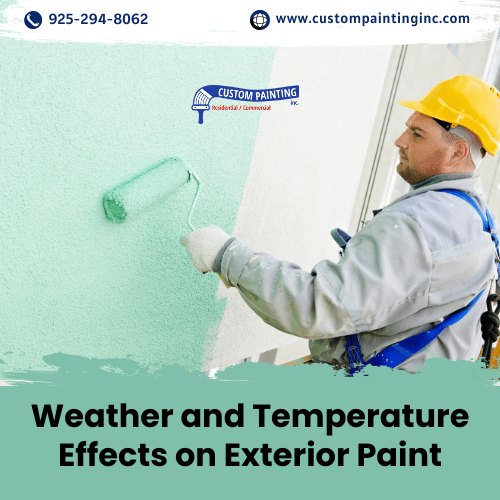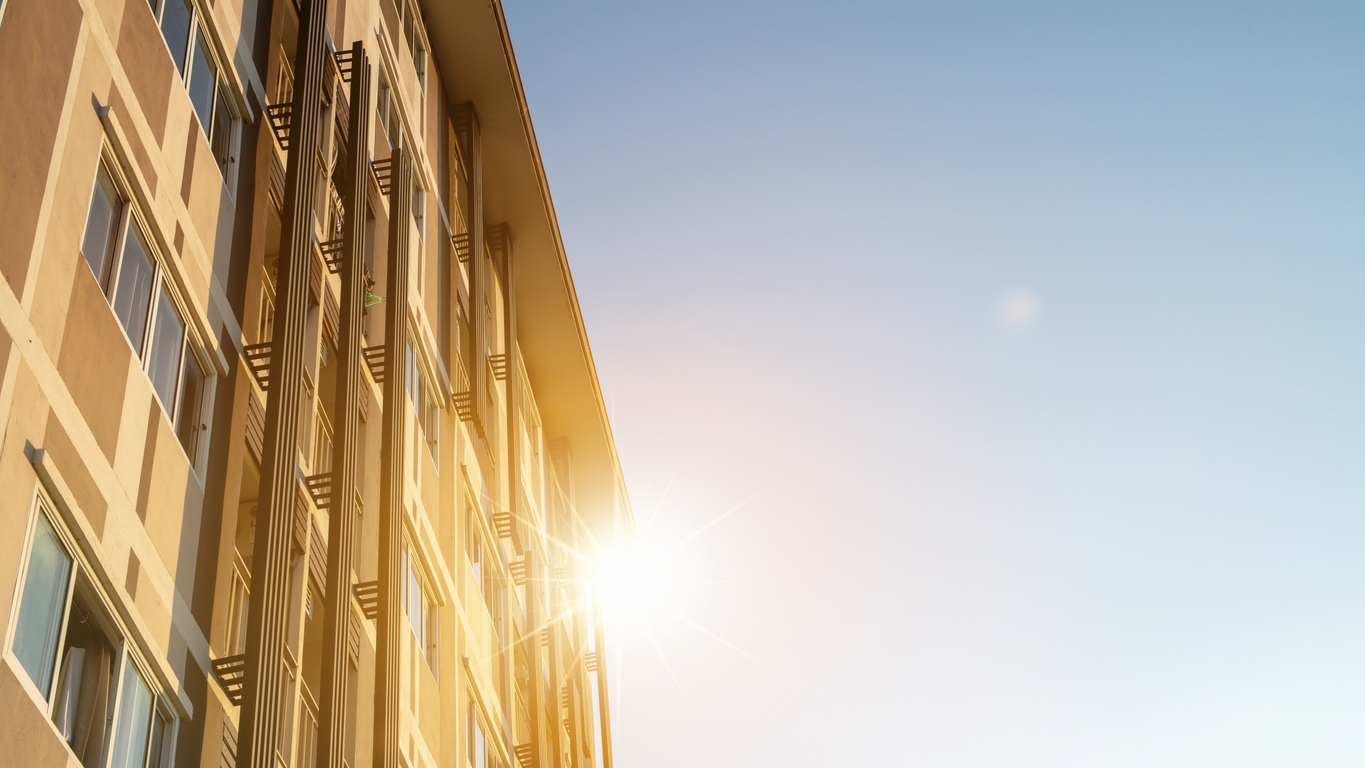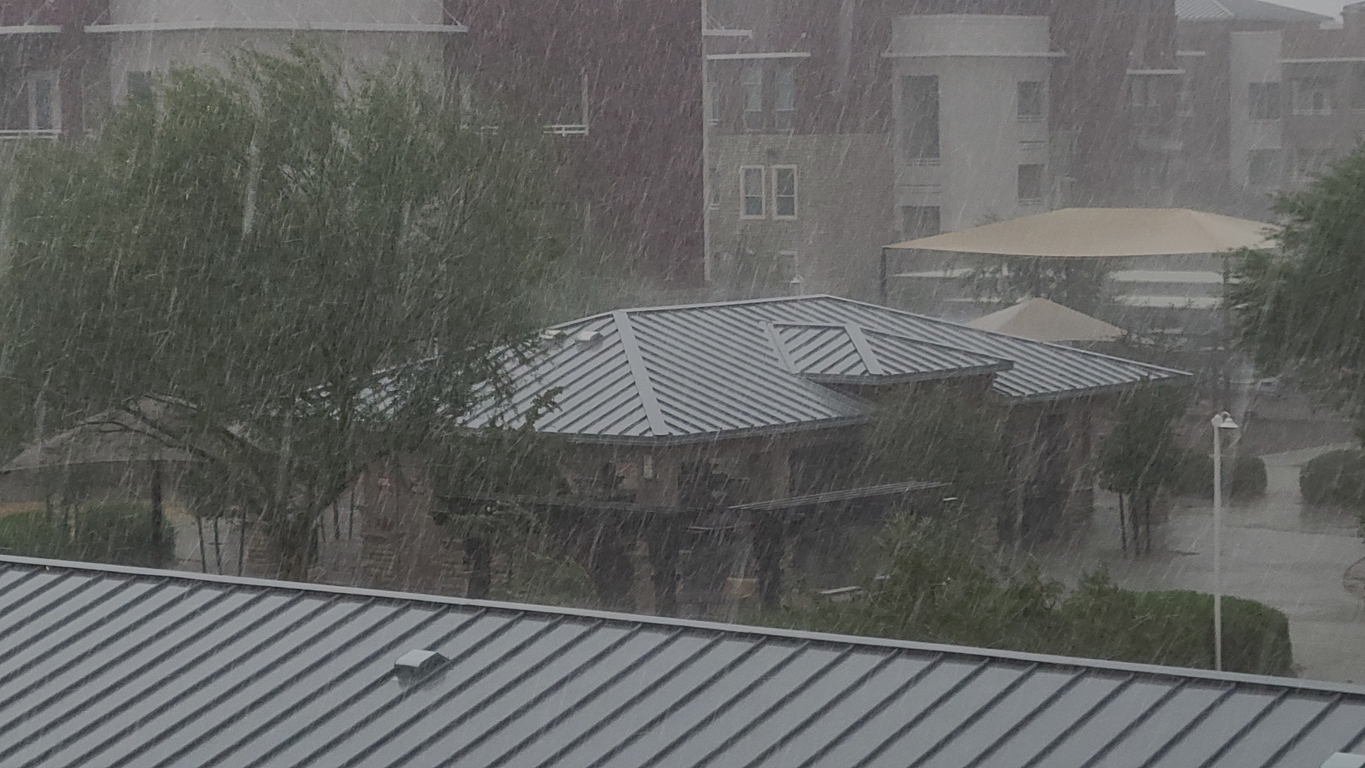Weather and outdoor temperatures are some of the significant issues affecting exterior paint, from the application to the finished paint job’s quality.
Choosing the right time to paint the exterior of a building is crucial for ensuring a successful and long-lasting finish. Weather and temperature conditions play a significant role in the application and curing of exterior paint. Extreme temperatures, high humidity, or rain can lead to issues like poor adhesion, uneven drying, or blistering.
Understanding these factors is essential for achieving a durable, professional finish that withstands the elements and maintains its appearance over time.
How temperature affects paint application
- Ideal temperature ranges: For optimal results in exterior painting, temperatures should generally be between 50°F and 85°F. This range allows the paint to adhere and cure properly.
- Cold weather risks: When temperatures drop, paint can thicken, resulting in uneven application. Cold conditions can also lead to cracking and poor adhesion, making it difficult for the paint to bond effectively to surfaces.
- Hot weather risks: High temperatures can cause paint to dry too quickly, leading to brush marks and uneven coverage. Rapid drying can reduce the bonding between layers, compromising the durability of the finish.
- Day and night temperature swings: Temperature fluctuations from day to night can significantly impact the curing process. As temperatures drop at night, it can hinder the paint’s ability to set correctly, potentially leading to defects in the finish.
Effects of humidity on exterior paint
- High humidity: Excessive moisture in the air can hinder proper paint drying, leading to issues like blistering or peeling. When paint doesn’t cure correctly, it can create an unstable surface, resulting in premature failure.
- Low humidity: Moderate humidity levels are ideal for painting, as they allow the paint to dry at the correct rate without trapping moisture. It helps achieve a smooth finish and improves adhesion.
- Moisture-related issues: Painting during or just before rainy or excessively humid conditions increases the risk of mildew, mold, and bubbling. These problems can compromise the integrity of the paint and the surfaces underneath.
The role of sunlight and UV exposure
- Direct sunlight: Painting in direct sunlight can cause the paint to dry too quickly, which may result in issues like cracks, bubbles, or uneven texture. Rapid drying doesn’t allow for proper leveling or adhesion.
- UV damage over time: Continuous exposure to ultraviolet rays can degrade paint pigments, leading to fading, discoloration, and chalking. This degradation affects aesthetics and reduces the paint’s protective qualities.
- Shaded areas: Proper timing and planning are crucial when painting shaded areas. Paint these sections during optimal conditions to ensure an even application and a consistent finish across the entire exterior.
Rain and moisture considerations
- Waiting for dry weather: Avoid painting when rain is in the forecast because moisture can prevent paint from adhering correctly, leading to peeling and bubbling. Allow surfaces affected by rain or dew to dry thoroughly before painting.
- Drying time after rain: Generally, you should wait at least 24 to 48 hours after a rainstorm before starting exterior painting. This timeframe allows surfaces to dry completely, ensuring optimal adhesion and a smooth finish.
- Waterproofing and sealants: To protect exterior surfaces from moisture damage, apply waterproof coatings or moisture barriers before painting. These products create a protective layer that helps prevent water infiltration, extending the life of your paint job.
Wind and its impact on painting
- Windy conditions: Strong winds can carry debris and dust, which can stick to wet paint, resulting in a rough or damaged finish.
- Overspray issues: Wind can cause paint to overspray, leading to uneven application and unwanted paint drifting onto surfaces like windows or neighboring properties.
- Working in mild breezes: Mild breezes can be beneficial, helping paint dry evenly without drying too quickly or trapping moisture, promoting a smoother finish.
Seasonal considerations for exterior painting
- Spring and fall as ideal seasons: These seasons provide moderate temperatures and lower humidity, which help paint adhere properly and dry evenly, reducing the risk of bubbling or peeling.
- Challenges of summer painting: The heat can cause paint to dry too quickly, leading to an uneven finish. Work during early mornings or late afternoons when temperatures are cooler to address this issue.
- Winter painting challenges: Cold weather can slow down drying times and cause paint to become thick or tacky. Using cold-weather formulations and monitoring temperature fluctuations are essential to ensure proper application and adhesion.
Special paint formulations for extreme weather
- Cold-weather paint: Cold-weather paints are formulated for application in lower temperatures. They contain special resins and additives that enhance adhesion and durability, ensuring a durable bond even in chilly conditions. These paints help prevent issues like cracking and peeling.
- Heat-resistant paint: These paints withstand high temperatures, making them ideal for areas exposed to intense heat. They resist fading and blistering, maintaining their appearance and protective qualities even under direct sunlight or near heat sources.
- Moisture-resistant paint: Essential for high-humidity regions, moisture-resistant and mold-resistant paints are engineered to prevent mildew and mold growth. Their formulations repel moisture, protecting surfaces in areas prone to rain or excessive moisture, extending the paint job’s life.
Curing and drying time: What to expect
- Difference between drying and curing: Drying refers to the paint being dry to the touch, while curing is the complete chemical process that hardens the paint, enhancing its durability. Curing is crucial for the paint’s long-term performance and resistance to wear, moisture, and damage.
- How weather affects curing: Weather conditions, particularly temperature and humidity, significantly impact curing time. High humidity can slow curing, while extreme temperatures may cause paint to cure improperly. If paint doesn’t cure fully, it risks peeling, cracking, or fading prematurely.
- Patience for best results: Following the manufacturer’s guidelines regarding drying and curing times is essential. Waiting for optimal weather conditions and allowing adequate curing time ensures the best adhesion and longevity of the paint.
Weatherproofing and long-term maintenance
- Adding protective coatings: Applying UV-blocking or waterproofing topcoats can significantly extend the life of exterior paint by providing additional protection against harsh weather conditions, preventing fading, peeling, and moisture penetration.
- Scheduled maintenance: Regular maintenance (including cleaning and inspecting painted surfaces) allows homeowners to catch early signs of damage, such as chipping or mildew, which can be exacerbated by extreme weather. This proactive approach helps preserve the integrity of the paint job.
- Touch-up strategies: Addressing minor weather-related paint issues with touch-ups or protective treatments prevents them from escalating into more significant problems. By promptly fixing small areas, you can maintain the overall appearance and longevity of the exterior paint, reducing the need for extensive repainting.
Professional expertise in managing weather challenges
- Why hire a professional? Experienced commercial painters can adapt to unpredictable weather conditions. Their expertise ensures that projects are completed successfully, even when faced with challenges like rain or extreme temperatures, ultimately leading to high-quality finishes.
- Monitoring and timing the project: Professionals continuously monitor weather forecasts, allowing them to schedule work during optimal conditions. This proactive approach helps avoid issues related to temperature fluctuations and moisture, ensuring proper adhesion and durability of the paint.
- Custom solutions for your building: Professional painters can recommend specific paints and application techniques suited to the local climate and your building’s exposure to the elements. This tailored approach enhances the longevity and performance of the paint job, protecting your investment against weather-related wear.
Parting words
Crucial weather and temperature factors, including ambient temperature, humidity levels, and sun exposure, affect the exterior painting. Ideal conditions typically involve moderate temperatures (between 50°F and 85°F), low humidity to prevent moisture issues, and avoiding direct sunlight during application to ensure a smooth finish.
Should you need help with your paint project, the experts at Custom Painting, Inc. are ready for the job. Call us at 925-294-8062 or message us on our contact page for a free consultation and quote.
For expert exterior painting services that account for weather challenges and ensure long-lasting results, contact Custom Painting, Inc. today!



